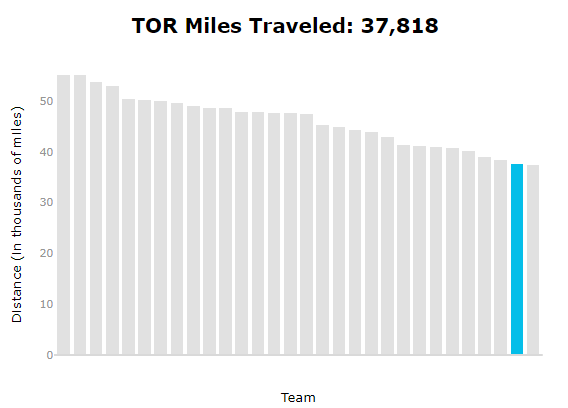When the 2017-18 schedule for the Toronto Raptors came out yesterday, the first thing that stood out was a remarkably difficult start: A home game against the team’s Achilles heel in the Chicago Bulls, a night hosting the will-still-be-healthy Philadelphia 76ers, and then an arduous six-game west-coast road-trip. Even with the benefit of some continuity and chemistry, the Raptors struggling out of the gate, in terms of record, would be forgivable, even if it’s not the expectation. The Raptors also have a difficult week in January with games against the Cleveland Cavaliers and Golden State Warriors, and they have a three-game set of Boston-Cleveland-Boston late in the year.
It’s easy to look at the tough start, tough end, and tough middle stretch and assume the schedule is tough overall. That’s an easy takeaway skimming the schedule and leaning on the primacy effect. Plus, I think there’s always a pull to look for the worst in a schedule (like 20 of their first 33 games being on the road), or to frame things based on your personal preference (some prefer a tough start as a galvanizing force, some prefer to ease in and slowly build with a young roster, and so on).
In any case, the truth usually lies somewhere between the initial polar reactions. Luckily, we have people like Jared Dubin and Ed Kupfer doing big-picture schedule work to help better inform us about exactly what kind of shake the Raptors got. At least, as much as we can evaluate such things in mid-August.
What follows are some relevant images and facts about the Raptors’ schedule this year.
Strength of Schedule – Opponent
Based solely on last season’s performances, the Raptors have the 28th-most difficult schedule (third easiest), which makes sense as a good Eastern Conference team – they play the West less often and can’t play themselves (only Cleveland and Boston have easier schedules by this measure).
Every NBA team's 2017-18 strength of schedule ranked by 2016-17 W-L% and Pythagorean Expectation. Suns toughest, Cavaliers easiest. pic.twitter.com/DR11MeuWNW
— Yaya Dubin (@JADubin5) August 15, 2017
Jared also broke this down by pre- and post-break. The Raptors have a top-10 easiest schedule in both halves, though it’s a little easier based only on opponent in the first half.
Every NBA team's pre- and post-ASG SOS, as well as pre-post differential. DAL starts tough, WAS easy. PHX closes tough, CHA easy. pic.twitter.com/IGcjOrqkyF
— Yaya Dubin (@JADubin5) August 15, 2017
And Ed took a look at this month-by-month, determining the Raptors have the fourth-easiest schedule (Miami has it easier by Ed’s measure). Looking at this, Toronto’s schedule looks quite easy in December and roughly average the rest of the way.
https://twitter.com/EdKupfer/status/897457066968797184
Strength of Schedule – Travel and Rest
Of course, the quality of opponents based on last year only tells us so much. We can’t really create a strength of schedule based on offseason moves (you could use ESPN’s RPM projections maybe, but DeMar DeRozan would probably tell you “FOH”). We can get a better picture by looking at things like travel and rest, though. Thankfully, Positive Residual has come through over at Nylon Calculus with a cool schedule breakdown tool.
First, we can see this neat map of their travel for the year.
That’s nice to look at but doesn’t quantify anything for us. Quantifying the travel on the schedule is quite revealing, as the Raptors travel the second-fewest amount of miles in the entire league this year. They also travel less than any other team after the All-Star break, so they could conceivably
Miles traveled is just one measure, but it speaks to the potential value of getting a lot of west-coast games out of the way on one long trip and then spending the bulk of the remainder of the season in one time zone. By traveling less than other teams, the Raptors could be at a disadvantage during the long trip but at a relative rest advantage or neutral position the rest of the time – the Raptors are at a rest disadvantage 19 times (tied for fifth fewest) and at a rest advantage 20 times (low-middle of the pack). They also have 14 back-to-backs, just below the league average of 14.4.
Takeaways
There’s no real way to say whether the schedule sets up favorably, or how much so. So much of it comes down to preference of sequencing and how good teams actually end up being. What we do know, though, is that the Raptors have a built-in edge being in the East, that even within the East they avoid good teams like Cleveland, Milwaukee, and Miami teams a fourth time, and that they travel less than almost any other team in the league, especially down the stretch. Early six-game trip aside, it’s hard not to look at all of that and gain a sense of moderate comfort in Toronto’s ability to navigate this slate and remain at the approximate level to which they’ve become accustomed.





